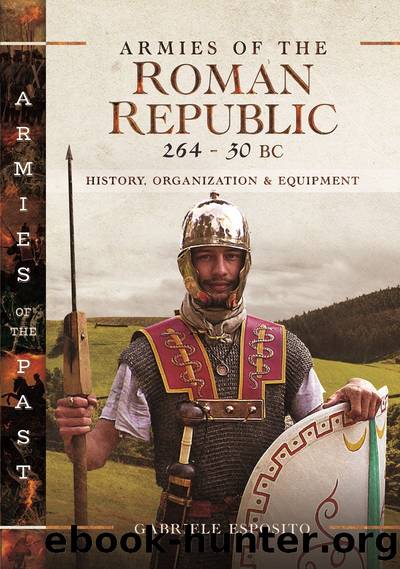Armies of the Roman Republic 264-30 BC: History, Organization and Equipment (Armies of the Past) by Gabriele Esposito

Author:Gabriele Esposito [Gabriele Esposito]
Language: eng
Format: epub
ISBN: 9781399094023
Google: awlAzwEACAAJ
Publisher: Pen & Sword
Published: 2023-03-14T21:00:00+00:00
Germanic warrior armed with throwing javelins. (Photo and copyright by Ancient Thrace)
Roman legionary wearing working dress, including a sun hat made of wicker. (Photo and copyright by Aera Legio I Consularis)
In 112 bc, the Roman Republic sent a large army to the Kingdom of Noricum, under the command of the consul Gnaeus Papirius Carbo. He was under orders to make an impressive show of force against the northern tribesmen in order to convince them that an invasion of Noricum was impossible. The Germani initially tried to negotiate with the Romans, asking for lands where they could settle, but it soon became clear that the legions had not crossed the Alps only to make a demonstration against them. As a result, the first battle between the Germani and the Romans was fought at Noreia, on the eastern borders of Noricum. This ended in disaster for the Roman legions and their Celtic allies, the Cimbri and Teutones crushing their opponents. Carbo escaped with his life only with great difficulty, and Romeâs army that had been sent north was practically destroyed. The Romans had been taken by surprise, discovering that the Germani were completely different from any other people that they had encountered in battle. The determination and courage of the Germani were unrivalled in the Ancient World, even if their warriors had only very simple personal equipment that did not include a cuirass like those worn by the Romans and Celts. The legionaries were shocked by the fighting methods of these barbarians from the north, fear playing a significant part in the early defeats suffered by the Romans at the hands of the Germani. The Roman Senate punished Carbo for his defeat, removing him from his position as consul and causing his subsequent suicide. The Italian peninsula now lay open to invasion by the Cimbri and Teutones, the Alps having been crossed by the Germani and no other Roman troops remaining between them and the heart of Italy. When it seemed that a new sack of Rome was imminent, something quite unexpected happened: the Cimbri and Teutones, rather than moving south through Italy, instead turned west.
They crossed Switzerland and crushed the Helvetii confederation, one of whose tribes, the Tigurini, joined the Germani in their migration and moving with them towards Gaul. In 109 bc, the Cimbri and Teutones devastated most of Provence, after having defeated the local forces of Rome. This led to the creation of a stable and formal alliance between the Germani and the Celtic Tigurini, which was an extremely dangerous situation for the Romans. Within a few years, the Cimbri and Teutones had completely destroyed the network of alliances that Rome had created around the Alps for the protection of Italy: the Kingdom of Noricum had been invaded and sacked, part of the Helvetii had joined the newcomers and Roman Provence had been ravaged. The Senate sent a new army against the Germani in 107 bc, attacking a large camp that they had built at Burdigala (present-day Bordeaux). However,
Download
This site does not store any files on its server. We only index and link to content provided by other sites. Please contact the content providers to delete copyright contents if any and email us, we'll remove relevant links or contents immediately.
The Daily Stoic by Holiday Ryan & Hanselman Stephen(3239)
The Fate of Rome: Climate, Disease, and the End of an Empire (The Princeton History of the Ancient World) by Kyle Harper(3007)
People of the Earth: An Introduction to World Prehistory by Dr. Brian Fagan & Nadia Durrani(2702)
Ancient Worlds by Michael Scott(2627)
Babylon's Ark by Lawrence Anthony(2622)
The Daily Stoic by Ryan Holiday & Stephen Hanselman(2466)
Foreign Devils on the Silk Road: The Search for the Lost Treasures of Central Asia by Peter Hopkirk(2435)
India's Ancient Past by R.S. Sharma(2417)
MOSES THE EGYPTIAN by Jan Assmann(2374)
The Complete Dead Sea Scrolls in English (7th Edition) (Penguin Classics) by Geza Vermes(2238)
Lost Technologies of Ancient Egypt by Christopher Dunn(2196)
The Earth Chronicles Handbook by Zecharia Sitchin(2182)
24 Hours in Ancient Rome by Philip Matyszak(2053)
Alexander the Great by Philip Freeman(2035)
Aztec by Gary Jennings(1977)
The Nine Waves of Creation by Carl Johan Calleman(1885)
Curse Tablets and Binding Spells from the Ancient World by Gager John G.;(1839)
Before Atlantis by Frank Joseph(1814)
Earthmare: The Lost Book of Wars by Cergat(1793)
